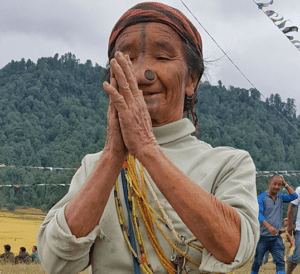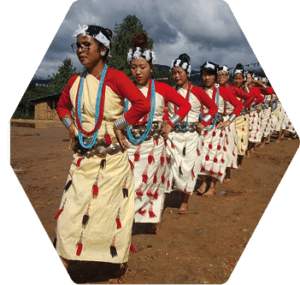Life
Call From the Hills

Hornbill Festival, Nagaland
Today an estimated 50 festivals are held in various mountainous regions of India.
India, which is lined with majestic mountains from the Himalayan Ranges in the north to Western Ghats in the south, had done little to promote the mystic beauty of its many unknown hill stations. But the regions are experiencing a new lease of life with a growing cultural, literary, music and film festival scene.
Imagine yourself surrounded by verdant pastures amidst pine-clad hills at a world-heritage site. The paddy fields near you rustle gently against the balmy breeze, while you sway to the rhythmic sound of music. No, this not a scene lifted from a fantasy novel. This is the poetic experience at the Ziro Music Festival, held annually in Ziro, Arunachal Pradesh.

Ziro Festival
Since 2012, Ziro, a picturesque hill station 1,500 meters above sea level in Northeast India, has been playing host to some of the most promising artists from around the world at its annual music festival. The plateau with its pristine forests, rivulets and pisciculture trade has long been amongst the best-kept secrets of the Indian mountains.
India, which is lined with majestic mountains from the Himalayan Ranges in the north to Western Ghats in the south, had done little to promote the mystic beauty of its many unknown hill regions. But the regions are experiencing a new lease of life with a growing cultural, literary, music and film festival scene.
Some of these festivals are promoted as platforms for neglected local artists. Many others, modeled along the lines of festivals and events in the West, strive to attract foreign tourists by promoting them as events in exotic locales in the cooler climes of the country.
Festivals often serve to shine a spotlight on obscure regions. The Sundance Film Festival in Park City, Utah, is revered around the world despite the fact that it is held in a relatively small, non-glamorous town far removed from Hollywood. The Rio Carnival, where more than 2 million people from around the world, gather on the streets of Rio de Janeiro every year, has been singularly responsible in putting the city on the global party map.
The success of the Jaipur Literature Festival, launched in 2006, which today is the world’s largest free literary festival, has given a major boost to festivals catering to art aficionados, bibliophiles and music lovers all over India. Growing awareness about various festivals around the world has prompted broader Indian interests in these events
Srishti Jha who has been a regular attendee at many Indian festivals says: “While everything in India becomes a ‘trend,’ and sometimes the visitors don’t care about what makes a film, literature or an art festival, but what is also true is that there is a community of artists and cinema lovers who care about such initiatives. What one needs to realize is that festivals are not just touristy escapes that one can flaunt on social media, but are much larger than that. However, ultimately, it is the level of hard work in curating that separates the good from the mediocre.”
Today an estimated 50 festivals, both big and small, are held in various mountainous regions of India. These festivals range from ones promoting regional crafts to those drawing some of the biggest filmmakers and artists from the West to India.
Some of these festivals in remote and conflict areas also introduce their alternate side in popular parlance. For instance, earlier this year, 85 films from 29 countries were screened at the three-day long Kargil International Film Festival. Meraj Sidiqui, director of the festival, said: “It is only to change the image of Kargil as a war zone to the world and show the world the beautiful culture, tradition and ethnicity of the district.”
Promoting Local
Dharamshala International Film Festival (DIFF) is a yearly event organized in the small, but cosmopolitan city of Dharamshala, nestled amongst the hills of Dhauladhar Himalayan mountain range. Conceptualized in 2012, the curated festival showcases some of the most sought after fiction, documentary and short-films.
Ritu Sarin, co-founder of DIFF, says: “There are today a lot of festivals happening in India in deserts, in beaches and in the hills. And while I cannot comment on the locations for other festivals, but in our case we chose Dharamshala because we have been living here for 21 years. It was our natural instinct to give back to the place we belonged to. For us it is an outreach activity. The local community is our big focus.”
Refreshingly, unlike other big-ticket festivals in which tickets are booked far in advance, cinema lovers simply queue up at the Tibetan Village School located near the forests in McLeodganj.
More than anything else, festival organizers say that unusual destinations help bring their stories out to the world. In November, the second edition of Kashmir World Film Festival was held at which 30 films were screened over five days. Filmmaker Govind Nihlani said: “The agenda of this festival is to walk, talk and make films on Kashmir.”
Fashion consultant and writer Srishti Jha says: “The mediums of art need to explore spaces that cast a different perception on viewers mind.
The experiential factor plays a significant role in seeing any performance of art. Besides, such initiatives give the local communities an access to good alternate cinema.”
Western Appeal
Organizers of these festivals in offbeat Indian cities point to the infrastructural challenges in small, inaccessible towns. Both domestic and foreign tourists find the sites appealing, but managing their travel is fraught with great difficulties, says Arijit Purkayastha, CEO of Koyeli Travels, which organize travel packages to many northeastern festivals, such as the Hornbill Festival in Kohima, Nagaland; Silk & Dye Fesival, Kaziranga, Assam; and Sangai Festival, Imphal Manipur.

Silk & Dye Festival, Kaziranga
Purkayastha says, “While there is no harm in attracting both international and domestic visitors, but surely the infrastructure in such harsh terrains is not conducive to smoothly host a world festival.”
He says: “Such festivals are a great opportunity for a place to showcase what it offers, but even during the famous Hornbill Festival, which has gained international recognition, there is utter chaos in Kohima. We always tell our international tourists to come with an adventurous mindset. We inform them that infrastructure in this part of the world may not be smooth and it will be lot different from let’s say a trip to Taj Mahal. But despite this people want to come.”
Indeed, says Lubna Shaheen, consultant, Ziro Music Festival, “There have been so many reputed bands from the U.S., UK and other countries that have been coming to perform during these festivals in India. I am sure they too must be feeling it is equally worthwhile to come to us.”
While the festivals have been growing organically and some, such as the Ziro festival, have grown from 300 guests in its inaugural year to 6,000 guests last year, organizers say the potential is far larger with corporate support.
Shaheen says: “Every time we approach the big corporates we get familiar excuses such as it is too far, there is no distribution network and the works. Until that changes we will have challenges.”
Ritu Sarin of DIFF concurs, “When we started there was no theater or cinema in Dharamshala and there have been a range of problems ranging from infrastructure to finances. A lack of corporate support remains a problem that we all face.”

Ziro Festival. Photo: Lubna Shaheen
Organizers hope to change that by giving domestic audiences exposure to the untapped potential of many local destinations. For far too long, major Indian filmmakers have opted for picturesque Western destinations, such as the Swiss Alps, over locally available sites. At the recent Kargil International Film Festival, the organizers expressed the hope that these untapped locations catch the eye of Bollywood and Hollywood filmmakers.
Shaheen says: “I would say that there is an acute need of showing the beauty of our hills. The northeast especially has been left unexplored. While Assam has still seen some wildlife tourism, because of Kaziranga National Park and Tawang in Arunachal Pradesh has been working on it, there is still a need to promote tourism in other parts.”
The festivals serve to open windows to the little-known facets of these regions. Says Purkayastha, “Thanks to the festivals so many other local things, such as Naga chilly or the fact that there is a short spring blossom season in Meghalaya, too have gained international recognition.”

1 Comment
You must be logged in to post a comment Login